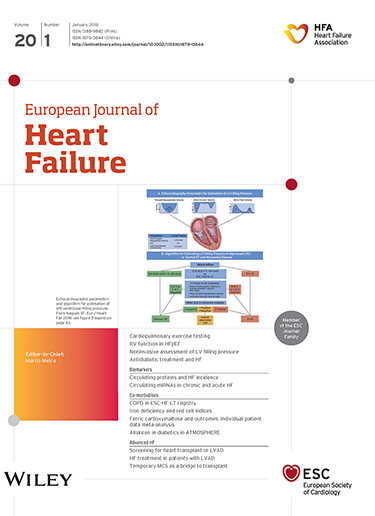有心力衰竭风险的中年人对严重肥胖的不同血容量和左心室适应性。
IF 10.8
1区 医学
Q1 CARDIAC & CARDIOVASCULAR SYSTEMS
引用次数: 0
摘要
肥胖通常被假设为导致心力衰竭(HF)的发展,部分原因是血容量(BV)增加和左心室(LV)重构。在HF发病前风险增加(IR)的中年个体中,肥胖和肥胖严重程度是否与BV扩张和随后的左室重构相关尚不清楚。方法和结果我们分析了96名中年(40-64岁)非肥胖(25.8 [23.6-28.6]kg/m2)对照(CON)和126名IR中年成人(心脏生物标志物升高加上已确定的危险因素)的数据。IR成人根据体重指数分级:(1)30-35 kg/m2, iri级(n = 39, 33 [31.9-33.6] kg/m2);(3) II类/III类>35 kg/m2, irii类/III类(n = 59, 41.2 [37.1-43.8] kg/m2)。评估BV(一氧化碳再呼吸)、身体组成(氢密度仪或双能x线吸收仪)和左室结构和功能(超声心动图)。脂肪量与BV独立相关(β = 0.17, p < 0.001),与左室舒张末期容积(LVEDV)指数独立相关(β = 0.54, p < 0.001)。CON组BV(5046±1123 ml)低于所有IR组(非肥胖组:5622±1137;ⅰ类组:6033±1237;ⅱ/ⅲ类组:6548±1153 ml,均p < 0.05)。即使在归一化至无脂质量后(CON: 36.2±4.6;irii /III: 39.9±5.1 ml/kg无脂质量;p < 0.001), irii /III类与CON相比红细胞体积更大(p < 0.005)。与CON和irnon - obesity相比,只有irii /III类的左室舒张末期容积与体表面积归一化后增大(p < 0.05)。结论瘦肉质量是BV的主要决定因素,脂肪质量与BV扩张和LVEDV增大独立相关。II/III级肥胖的IR成人表现出与体型不成比例的明显左室增大(即LVEDV指数),可能代表了生理上不同的肥胖亚组,而不是简单的疾病严重程度连续体。本文章由计算机程序翻译,如有差异,请以英文原文为准。
Distinct blood volume and left ventricular adaptation to severe obesity in middle-aged adults at risk for heart failure.
AIMS
Obesity is commonly hypothesized to lead to the development of heart failure (HF) in part due to increases in blood volume (BV) and left ventricular (LV) remodelling. Whether adiposity and obesity severity are associated with BV expansion and subsequent LV remodelling in middle-aged individuals at increased risk (IR) prior to the onset of HF is unknown.
METHODS AND RESULTS
We analysed data from 96 middle-aged (40-64 years) non-obese (25.8 [23.6-28.6] kg/m2) controls (CON) and 126 IR middle-aged adults (elevated cardiac biomarkers plus established risk factors). IR adults were stratified based upon body mass index class: (1) <30 kg/m2, IRNon-Obese (n = 28, 28.2 [24.6-29.9] kg/m2); (2) Class I >30-35 kg/m2, IRClass-I (n = 39, 33 [31.9-33.6] kg/m2); and, (3) Class II/III >35 kg/m2, IRClass-II/IIII (n = 59, 41.2 [37.1-43.8] kg/m2). BV (carbon monoxide rebreathing), body composition (hydrodensitometry or dual-energy X-ray absorptiometry), and LV structure and function (echocardiography) were assessed. Fat mass was independently associated with BV (β = 0.17, p < 0.001) which was independently associated with LV end-diastolic volume (LVEDV) index (β = 0.54, p < 0.001). BV was lower in CON (5046 ± 1123 ml) than all IR groups (IRNon-Obese: 5622 ± 1137; IRClass-I: 6033 ± 1237; IRClass-II/III: 6548 ± 1153 mL; all p < 0.05). IRClass-II/III had greater erythrocyte volume compared to CON (p < 0.005), even after normalization to fat-free mass (CON: 36.2 ± 4.6; IRClass-II/III: 39.9 ± 5.1 ml/kg fat-free mass; p < 0.001). Only IRClass-II/III had an enlarged LV end-diastolic volume when normalized to body surface area compared to both CON and IRNon-Obese (both, p < 0.05).
CONCLUSIONS
While lean mass is the primary determinant of BV, fat mass is independently associated with BV expansion and larger LVEDV. IR adults with class II/III obesity display distinct LV enlargement that is disproportionate to body size (i.e. LVEDV index) and may represent a physiologically distinct subgroup of obesity as opposed to a simple continuum of disease severity.
求助全文
通过发布文献求助,成功后即可免费获取论文全文。
去求助
来源期刊

European Journal of Heart Failure
医学-心血管系统
CiteScore
27.30
自引率
11.50%
发文量
365
审稿时长
1 months
期刊介绍:
European Journal of Heart Failure is an international journal dedicated to advancing knowledge in the field of heart failure management. The journal publishes reviews and editorials aimed at improving understanding, prevention, investigation, and treatment of heart failure. It covers various disciplines such as molecular and cellular biology, pathology, physiology, electrophysiology, pharmacology, clinical sciences, social sciences, and population sciences. The journal welcomes submissions of manuscripts on basic, clinical, and population sciences, as well as original contributions on nursing, care of the elderly, primary care, health economics, and other related specialist fields. It is published monthly and has a readership that includes cardiologists, emergency room physicians, intensivists, internists, general physicians, cardiac nurses, diabetologists, epidemiologists, basic scientists focusing on cardiovascular research, and those working in rehabilitation. The journal is abstracted and indexed in various databases such as Academic Search, Embase, MEDLINE/PubMed, and Science Citation Index.
 求助内容:
求助内容: 应助结果提醒方式:
应助结果提醒方式:


